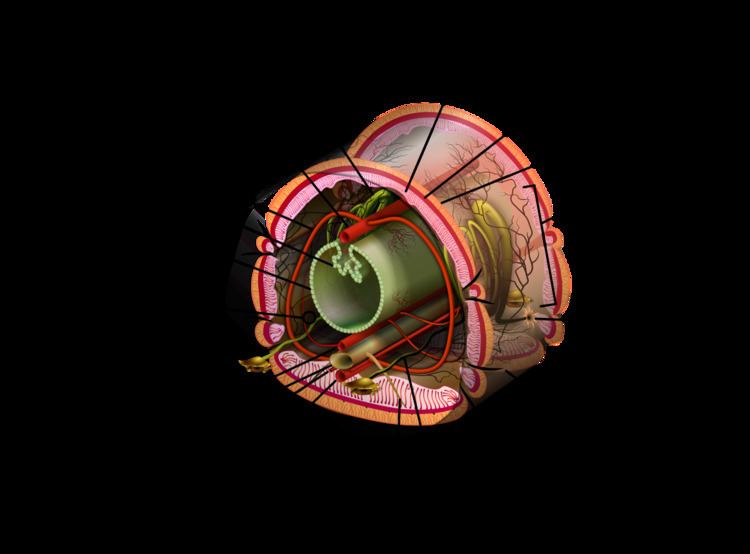Greek koilōma | ||
 | ||
The coelom (/ˈsiːləm/ SEE-ləm, plural coeloms or coelomata /siːˈloʊmətə/ see-LOH-mə-tə) (from Greek: κοῖλος koîlos, hollow, cavity) is the main body cavity in most animals and is positioned inside the body to surround and contain the digestive tract and other organs. In developed animals, it is lined with a mesodermal epithelium. In other animals, such as molluscs, it remains undifferentiated.
Contents
Development
Coelom formation begins in the gastrula stage. The developing digestive tube of an embryo forms as a blind pouch called the archenteron.
In Protostomes, the coelom forms by a process known as schizocoely. The archenteron initially forms, and the mesoderm splits into two layers: the first attaches to the body wall or ectoderm, forming the parietal layer and the second surrounds the endoderm or alimentary canal forming the visceral layer. The space between the parietal layer and the visceral layer is known as the coelom or body cavity.
In Deuterostomes, the coelom forms by enterocoely: mesoderm buds from the walls of the archenteron and hollows to become the coelomic cavities.
Origins
The evolutionary origin of the coelom is uncertain. The oldest known animal to have had a body cavity was the Vernanimalcula. Current hypothesis include:
Function
A coelom can absorb shock or provide a hydrostatic skeleton. It can also support an immune system in the form of coelomocytes that may either be attached to the wall of the coelom or may float about in it freely. The coelom allows muscles to grow independently of the body wall — this feature can be seen in the digestive tract of tardigrades (also known as water bears) which is suspended within the body in the mesentery derived from a mesoderm-lined coelom.
Coelomic fluid
The fluid inside the coelom is known as coelomic fluid. This is circulated by mesothelial cilia or by contraction of muscles in the body wall which are themselves of mesin. The coelomic fluid serves several functions; it acts as a hydroskeleton, it allows free movement and growth of internal organs, it serves for transport of gases, nutrients and waste products between different parts of the body, it allows storage of sperm and eggs during maturation and it acts as a reservoir for waste.
Classification in zoology
In the past, some zoologists (e.g., Hyman, 1940) grouped bilaterian animal phyla based on characteristics related to the coelom for practical purposes, not intending that each of those groups (Acoelomata, Pseudocoelomata and Coelomata) were natural, that is, that their phyla were phylogenetically related. This scheme was followed by a number of college textbooks (even recent as Margulis & Chapman, 2009) and some general classifications (e.g., Whittaker, 1969), but is now almost totally abandoned as a formal classification. However, some authors of recent molecular phylogeny studies misleadingly called this classification scheme as the "traditional, morphology-based phylogeny".
Thereby, animals can be classified in three informal groups according to the type of body cavity they possess, in a not taxonomic, utilitarian way:
Coelomates
Coeloms developed in triploblasts but were subsequently lost in several lineages. The lack of a coelom is correlated with a reduction in body size. Coelom is sometimes incorrectly used to refer to any developed digestive tract. Some organisms may not possess a coelom or may have a false coelom (pseudocoelom). Animals having coeloms are called coelomates, and those without are called acoelomates. There are also subtypes of coelom:
Coelomate phyla
According to Brusca and Brusca, the following bilaterian phyla possess a coelom:
For others, the coelomate phyla excludes Nemertea but also comprises Entoprocta, Pentastoma, Pogonophora (i.e., from tiny sessile aquatic animals to great whales and everything in between).
Pseudocoelomates
In some protostomes, the embryonic blastocoele persists as a body cavity. These protostomes have a fluid filled main body cavity unlined or partially lined with tissue derived from mesoderm.
This fluid-filled space surrounding the internal organs serves several functions like distribution of nutrients and removal of waste or supporting the body as a hydrostatic skeleton.
A pseudocoelomate or blastocoelomate is any invertebrate animal with a three-layered body and a pseudocoel. The coelom was apparently lost or reduced as a result of mutations in certain types of genes that affected early development. Thus, pseudocoelomates evolved from coelomates. "Pseudocoelomate" is no longer considered a valid taxonomic group, since it is not monophyletic. However, it is still used as a descriptive term.
Important characteristics:
Pseudocoelomate phyla
According to Brusca and Brusca, bilaterian pseudocoelomate phyla include:
Some authors list the following phyla as pseudocoelomates:
Acoelomates
Acoelomates lack a fluid-filled body cavity between the body wall and digestive tract. This can present some serious disadvantages. Fluid compression is negligible, while the tissue surrounding the organs of these animals will compress. Therefore, acoelomate organs are not protected from crushing forces applied to the animal’s outer surface. The coelom can be used for diffusion of gases and metabolites etc. These creatures do not have this need, as the surface area to volume ratio is large enough to allow absorption of nutrients and gas exchange by diffusion alone, due to dorso-ventral flattening.
Acoelomate phyla
According to Brusca and Brusca, bilaterian phyla without a coelom include:
According to others, acoelomates include the cnidarians (jellyfish and allies), and the ctenophores (comb jellies), platyhelminthes (flatworms including tapeworms, etc.), Nemertea, and Gastrotricha.
